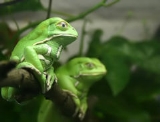
Phyllomedusa sauvagii
Encyclopedia
- Common names: waxy monkey frog, painted-belly leaf frog

South America
South America is a continent situated in the Western Hemisphere, mostly in the Southern Hemisphere, with a relatively small portion in the Northern Hemisphere. The continent is also considered a subcontinent of the Americas. It is bordered on the west by the Pacific Ocean and on the north and east...
and Central America
Central America
Central America is the central geographic region of the Americas. It is the southernmost, isthmian portion of the North American continent, which connects with South America on the southeast. When considered part of the unified continental model, it is considered a subcontinent...
n leaf frogs, Phyllomedusinae
Phyllomedusinae
Phyllomedusinae is a subfamily of Hylidae, the tree frogs. Commonly called leaf frogs, they are found in the Neotropics. The type genus Phyllomedusa contains more thean half of the known species within this subfamily.- Taxonomy :...
that inhabits the Chaco (dry prairie) of Argentina
Argentina
Argentina , officially the Argentine Republic , is the second largest country in South America by land area, after Brazil. It is constituted as a federation of 23 provinces and an autonomous city, Buenos Aires...
, Brazil
Brazil
Brazil , officially the Federative Republic of Brazil , is the largest country in South America. It is the world's fifth largest country, both by geographical area and by population with over 192 million people...
, Bolivia
Bolivia
Bolivia officially known as Plurinational State of Bolivia , is a landlocked country in central South America. It is the poorest country in South America...
and Paraguay
Paraguay
Paraguay , officially the Republic of Paraguay , is a landlocked country in South America. It is bordered by Argentina to the south and southwest, Brazil to the east and northeast, and Bolivia to the northwest. Paraguay lies on both banks of the Paraguay River, which runs through the center of the...
. The subfamily consists of around 50 species in three well known genera, Phyllomedusa
Phyllomedusa
Phyllomedusa is a genus of tree frog from Central and South America. It ranges from Costa Rica southward to Argentina. It has around thirty species.-Secretion:...
, Agalychnis
Agalychnis
Agalychnis is a genus of tree frogs native to forests in Mexico, Central America and northwestern South America.- Taxonomy :There used to be 8 species within the Agalychnis genus but a recent major revision of the Hylidae family moved two species to the newly created genus Cruziohyla leaving 6...
and Pachymedusa. The vast majority of known species, including Phyllomedusa sauvagei, belong to the Phyllomedusa genus.
Phyllomedusa sauvagii has adapted to meet the demands of life in the trees. It does not need to return to the ground during the mating season, rather it lays its eggs down the middle of a leaf before folding the leaf, sandwiching the eggs inside. Its nest is attached to a branch suspended over a stream so that hatching tadpole
Tadpole
A tadpole or polliwog is the wholly aquatic larval stage in the life cycle of an amphibian, particularly that of a frog or toad.- Appellation :...
s drop into the water. In common with other phyllomedusines, it presents physiological and behavioural adaptations to limit water loss including impermeabilisation of the skin by lipid
Lipid
Lipids constitute a broad group of naturally occurring molecules that include fats, waxes, sterols, fat-soluble vitamins , monoglycerides, diglycerides, triglycerides, phospholipids, and others...
secretions, excretion of uric acid
Uric acid
Uric acid is a heterocyclic compound of carbon, nitrogen, oxygen, and hydrogen with the formula C5H4N4O3. It forms ions and salts known as urates and acid urates such as ammonium acid urate. Uric acid is created when the body breaks down purine nucleotides. High blood concentrations of uric acid...
(uricotelism) and diurnal
Day
A day is a unit of time, commonly defined as an interval equal to 24 hours. It also can mean that portion of the full day during which a location is illuminated by the light of the sun...
torpor. Lipid secretions are produced in a special type of cutaneous gland and are spread over the surface of the skin by the legs in a complex sequence of wiping movements.
Males and females range from about 2 to 3 inches in length, with the females usually about 25% larger than males. They move by walking rather than hopping, which is the reason for the "monkey" in their name. They are very calm, careful creatures. During the day, they bask in the sun with their legs pulled underneath them, and hunt for various insects at night.
It is often kept as a pet.

